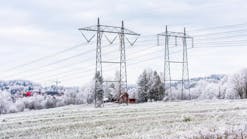For the last 100 years, there has only been one way to build capacity on our electric grid.
Grid infrastructure projects since Westinghouse first developed AC electric light networks have entailed complex and expensive engineering and construction work to design, permit, and build new power lines. These traditional projects can take up to 10 years to go from design to construction, and face increasing opposition from local residents and regulators.
Just last week, voters in Maine soundly rejected plans for a new high-voltage line to bring hydro power from Quebec through the state and onward to my home state of Massachusetts.
At a time when it is increasingly difficult to build grid infrastructure, the need to expand and modernize the grid has never been greater. A recent Princeton study showed that grid capacity will need to double by 2035 for a zero net carbon grid. And triple by 2050 to support electrification of transportation, buildings and industry.
And it is not just a larger grid that is required, but one that can withstand increasingly extreme weather events. Wildfires in the West, winter storm Uri in Texas, and Hurricane Ida in Louisiana have highlighted the fragility of our aging infrastructure and the need for a more resilient grid. In Texas alone, the economic impact from the February freeze and related grid outages exceeded $100B.
Fortunately, a new era of grid infrastructure investment has begun. One that leverages advanced sensors, batteries, analytics and electronics technologies to increase the capacity, flexibility and resilience of the grid we already have. Leading utilities such as the New York Power Authority, National Grid, Xcel Energy and Dominion have already begun deploying these technologies to achieve their clean energy commitments.
Unlike earlier smart grid technologies such as smart meters and synchrophasors, these technologies don’t simply give utilities more data. They optimize the way power is routed on the grid to reduce congestion, balance power flows across multiple paths, dynamically reroute power around outages, and unlock incremental capacity on existing lines.
A recent Brattle Group study showed that these grid enhancing technologies can double the amount of renewable energy integrated onto the grid, and deliver $5B in consumer cost savings nationally, with a payback in under six months. Importantly, these technologies can be deployed in weeks or months, not the 5-10 years required to build new lines, and at a unit cost of less than 5% of traditional projects.
The Infrastructure Bill signed by President Biden this week contains $65B for power system and grid infrastructure - by far the largest amount ever spent to modernize the electric grid. Several sections in the bill will accelerate the adoption of grid-enhancing technologies.
- $3 billion in funding has been designated for the Smart Grid Investment Matching Grant Program, for technologies such as Dynamic Line Ratings, Topology Control and Power Flow Control which increase the “operational transfer capacity of a transmission network.”
- $5 billion will go toward projects to prevent outages and enhance grid resilience, including investments in monitoring and control technologies.
- $2.5 billion will fund the Transmission Facilitation Program, for construction of new transmission lines, with priority given to projects incorporating Grid Enhancing Technologies.
To be clear, we will need to build new lines. Lots of them. But now we have a powerful new tool for grid expansion and resilience which will complement traditional grid infrastructure projects. The funding in the Infrastructure Bill is modest relative to the $360B some experts have said must be spent to upgrade the grid, but projects that leverage advanced grid technologies will have a powerful multiplier effect by enabling more efficient use of existing infrastructure. Adoption of these technologies is essential to a successful clean energy transition and ensuring the grid has the capacity, flexibility and resilience needed for the next 100 years.
Hudson Gilmer is co-founder and CEO of LineVision, inc.


